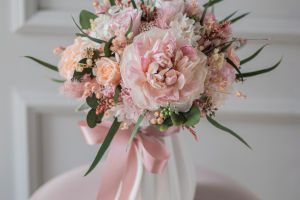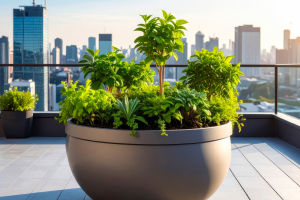Floral design has evolved over centuries from simple bouquets to elaborate, intricate creations. While traditional flower arrangements have a timeless charm, today's floral designers are pushing the boundaries of creativity.
By using new materials, experimenting with bold shapes, and incorporating innovative installation methods, modern flower design is breaking free from convention.
This article explores how contemporary floral art is redefining what flowers can be and how we can use them to make powerful statements in design.
Exploring New Materials in Modern Floral Design
One of the most exciting developments in modern floral design is the introduction of unconventional materials. No longer confined to just fresh flowers, designers are incorporating materials like metals, glass, plastic, and even fabric into their arrangements. These materials not only add texture and contrast but also allow designers to craft more durable, long-lasting floral installations.
For example, using clear acrylic or glass vases allows the focus to be solely on the flowers, but the transparent containers also offer the opportunity to incorporate colored water, lights, or floating elements that interact with the flowers in a dynamic way. Metal components like steel or copper are becoming increasingly popular for creating bold, modern structures that hold flowers in place while also adding an industrial edge to the design.
In addition to traditional fresh flowers, designers are also turning to dried flowers, which offer a more lasting alternative. Dried flowers, when paired with modern materials like concrete or wood, can evoke a rustic yet contemporary aesthetic that appeals to modern sensibilities. These mixed-materials designs are particularly popular in urban settings, where they add an earthy touch to sleek, minimalist spaces.
Breaking Traditional Shapes: New Forms of Floral Arrangements
Traditional flower arrangements often follow predictable patterns—circular, symmetrical, and compact. However, modern designers are experimenting with new forms that challenge these conventions. Asymmetry, abstraction, and free-flowing shapes are becoming more common, creating designs that feel more organic and dynamic.
For instance, cascading floral arrangements are gaining popularity in weddings and interior decor. Flowers arranged in a downward flow, creating a waterfall effect, add drama and movement to any space. Likewise, asymmetrical designs, where flowers are grouped unevenly or at varying heights, create a more relaxed and artistic look, moving away from rigid, perfectly balanced designs.
One striking example of modern floral forms is the "floral sculpture" concept, where flowers are used as part of larger, three-dimensional sculptures. These arrangements may take on the shape of animals, geometric patterns, or abstract art, making the flowers themselves part of an overall artistic expression. These bold, imaginative designs allow floral arrangements to transcend mere decoration and become pieces of art in their own right.
Incorporating Installations and Interactivity
Beyond vases and simple bouquets, modern floral design has embraced installations that turn flowers into immersive experiences. By creating large-scale flower installations, designers can engage viewers on a deeper level, allowing them to interact with the work. These installations often go beyond the boundaries of a tabletop arrangement or wall piece, taking over entire rooms, public spaces, or even outdoor landscapes.
One example of this is "flower walls," where an entire wall is covered with fresh or artificial flowers, creating a stunning, visual display. These installations are often used for events like weddings or fashion shows but are also making their way into commercial spaces like restaurants and hotels, where they act as both decor and a unique photo backdrop.
Interactive floral designs are also gaining traction. Designers are using technology to enhance the floral experience, such as incorporating motion sensors that trigger lights or sounds when someone walks by. In some cases, flowers are suspended in mid-air using transparent threads or frames, giving the illusion of floating blooms. This interactivity adds an element of surprise and wonder, creating a memorable experience for anyone who encounters the design.
Color and Texture Innovation: Pushing the Boundaries
The color palette in modern floral design is also evolving. While classic flowers are often associated with traditional colors like reds, whites, and pinks, contemporary designers are exploring a wider range of hues, including neon shades, metallics, and unconventional combinations.
For example, vibrant neon colors are being used to create a futuristic look, while metallic finishes on flowers, leaves, or vases add an element of luxury. Designers are mixing contrasting colors, like deep purples with bright oranges, to create dramatic and eye-catching arrangements. By combining unusual color pairings with textural contrasts—such as glossy petals paired with matte leaves or delicate flowers juxtaposed with rough, organic elements—designers can craft floral pieces that feel both modern and edgy.
The use of unconventional textures is also helping modern floral arrangements stand out. In addition to traditional petals, designers are adding unexpected elements like feathers, ribbons, beads, and even lights into their arrangements. These added layers of texture make the flowers feel more tactile and dynamic, elevating the design from simple beauty to a multisensory experience.
Floral Design and Sustainability: A Modern Approach
As the world becomes more eco-conscious, sustainable floral design has become a major trend in the modern floral industry. Designers are focusing on sourcing locally grown, organic flowers and using environmentally friendly materials in their arrangements. The trend toward sustainability is not just a passing phase; it reflects a larger shift toward conscious living and environmental responsibility.
In addition to using sustainable flowers, designers are also embracing upcycled materials in their arrangements. Recycled glass, repurposed wood, and biodegradable floral foam are just a few examples of how the floral industry is moving toward more sustainable practices. Not only does this make floral designs more eco-friendly, but it also gives designers the opportunity to showcase creativity through innovative material use.
Conclusion: The Future of Floral Design
Modern floral design is at the forefront of creativity and innovation, transforming what was once considered a traditional art form into a dynamic, forward-thinking practice. By embracing new materials, experimental shapes, and immersive installations, designers are able to challenge the norms of floral design and create stunning, creative works that captivate and inspire. The future of floral design lies in its ability to break free from tradition and explore the infinite possibilities that lie beyond the vase.
Are you ready to try something new in your flower arrangements? Whether you're designing for an event, your home, or simply experimenting with floral art, don't be afraid to think outside the vase and push the limits of what flowers can do.


